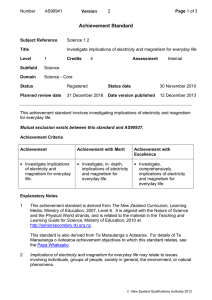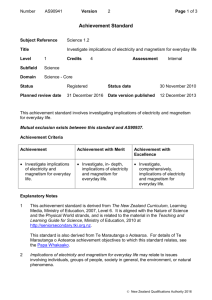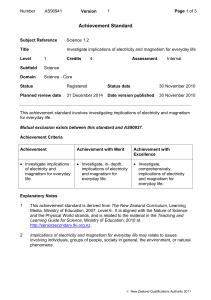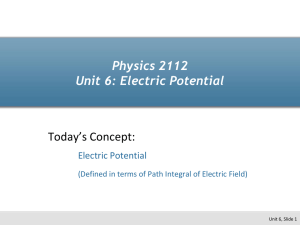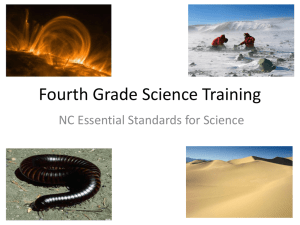Unp Std 90941 3col
advertisement
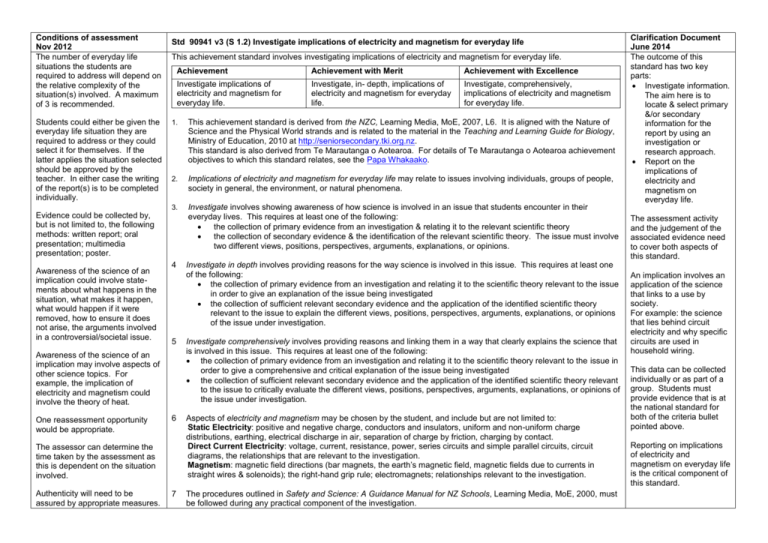
Conditions of assessment Nov 2012 The number of everyday life situations the students are required to address will depend on the relative complexity of the situation(s) involved. A maximum of 3 is recommended. Students could either be given the everyday life situation they are required to address or they could select it for themselves. If the latter applies the situation selected should be approved by the teacher. In either case the writing of the report(s) is to be completed individually. Std 90941 v3 (S 1.2) Investigate implications of electricity and magnetism for everyday life This achievement standard involves investigating implications of electricity and magnetism for everyday life. Investigate, comprehensively, implications of electricity and magnetism for everyday life. 2. Implications of electricity and magnetism for everyday life may relate to issues involving individuals, groups of people, society in general, the environment, or natural phenomena. 3. Investigate involves showing awareness of how science is involved in an issue that students encounter in their everyday lives. This requires at least one of the following: the collection of primary evidence from an investigation & relating it to the relevant scientific theory the collection of secondary evidence & the identification of the relevant scientific theory. The issue must involve two different views, positions, perspectives, arguments, explanations, or opinions. 4 5 6 The assessor can determine the time taken by the assessment as this is dependent on the situation involved. Authenticity will need to be assured by appropriate measures. Achievement with Excellence Investigate, in- depth, implications of electricity and magnetism for everyday life. This achievement standard is derived from the NZC, Learning Media, MoE, 2007, L6. It is aligned with the Nature of Science and the Physical World strands and is related to the material in the Teaching and Learning Guide for Biology, Ministry of Education, 2010 at http://seniorsecondary.tki.org.nz. This standard is also derived from Te Marautanga o Aotearoa. For details of Te Marautanga o Aotearoa achievement objectives to which this standard relates, see the Papa Whakaako. Awareness of the science of an implication may involve aspects of other science topics. For example, the implication of electricity and magnetism could involve the theory of heat. One reassessment opportunity would be appropriate. Achievement with Merit Investigate implications of electricity and magnetism for everyday life. 1. Evidence could be collected by, but is not limited to, the following methods: written report; oral presentation; multimedia presentation; poster. Awareness of the science of an implication could involve statements about what happens in the situation, what makes it happen, what would happen if it were removed, how to ensure it does not arise, the arguments involved in a controversial/societal issue. Achievement 7 Investigate in depth involves providing reasons for the way science is involved in this issue. This requires at least one of the following: the collection of primary evidence from an investigation and relating it to the scientific theory relevant to the issue in order to give an explanation of the issue being investigated the collection of sufficient relevant secondary evidence and the application of the identified scientific theory relevant to the issue to explain the different views, positions, perspectives, arguments, explanations, or opinions of the issue under investigation. Investigate comprehensively involves providing reasons and linking them in a way that clearly explains the science that is involved in this issue. This requires at least one of the following: the collection of primary evidence from an investigation and relating it to the scientific theory relevant to the issue in order to give a comprehensive and critical explanation of the issue being investigated the collection of sufficient relevant secondary evidence and the application of the identified scientific theory relevant to the issue to critically evaluate the different views, positions, perspectives, arguments, explanations, or opinions of the issue under investigation. Aspects of electricity and magnetism may be chosen by the student, and include but are not limited to: Static Electricity: positive and negative charge, conductors and insulators, uniform and non-uniform charge distributions, earthing, electrical discharge in air, separation of charge by friction, charging by contact. Direct Current Electricity: voltage, current, resistance, power, series circuits and simple parallel circuits, circuit diagrams, the relationships that are relevant to the investigation. Magnetism: magnetic field directions (bar magnets, the earth’s magnetic field, magnetic fields due to currents in straight wires & solenoids); the right-hand grip rule; electromagnets; relationships relevant to the investigation. The procedures outlined in Safety and Science: A Guidance Manual for NZ Schools, Learning Media, MoE, 2000, must be followed during any practical component of the investigation. Clarification Document June 2014 The outcome of this standard has two key parts: Investigate information. The aim here is to locate & select primary &/or secondary information for the report by using an investigation or research approach. Report on the implications of electricity and magnetism on everyday life. The assessment activity and the judgement of the associated evidence need to cover both aspects of this standard. An implication involves an application of the science that links to a use by society. For example: the science that lies behind circuit electricity and why specific circuits are used in household wiring. This data can be collected individually or as part of a group. Students must provide evidence that is at the national standard for both of the criteria bullet pointed above. Reporting on implications of electricity and magnetism on everyday life is the critical component of this standard.
